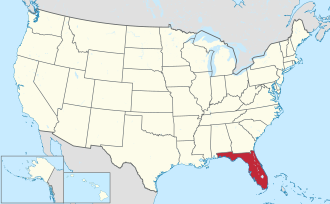Taylor County, Florida | |
|---|---|
 Taylor County Courthouse | |
 Location within the U.S. state of Florida | |
 Florida's location within the U.S. | |
| Coordinates: 30°01′N83°37′W / 30.02°N 83.62°W | |
| Country | |
| State | |
| Founded | December 23, 1856 |
| Named after | Zachary Taylor |
| Seat | Perry |
| Largest city | Perry |
| Area | |
• Total | 1,232 sq mi (3,190 km2) |
| • Land | 1,043 sq mi (2,700 km2) |
| • Water | 189 sq mi (490 km2) 15.3% |
| Population (2020) | |
• Total | 21,796 |
• Estimate (2023) | 21,582 |
| • Density | 20.90/sq mi (8.069/km2) |
| Time zone | UTC−5 (Eastern) |
| • Summer (DST) | UTC−4 (EDT) |
| Congressional district | 2nd |
| Website | www |
Taylor County is a county located in the Big Bend region in the northern part of the U.S. state of Florida. As of the 2020 census, the population was 21,796. [1] Its county seat is Perry. [2] The county hosts the annual Florida Forest Festival and has been long known as the "Tree Capital of the South" since a 1965 designation from then-Governor W. Haydon Burns. [3]
Contents
- History
- Geography
- Adjacent counties
- National protected area
- Demographics
- 2020 census
- 2000 census
- Education
- Library
- Communities
- Town
- Census-designated place
- Other unincorporated communities
- Politics
- Transportation
- Airports
- Major highways
- See also
- References
- External links
- Government links/Constitutional offices
- Tourism links


